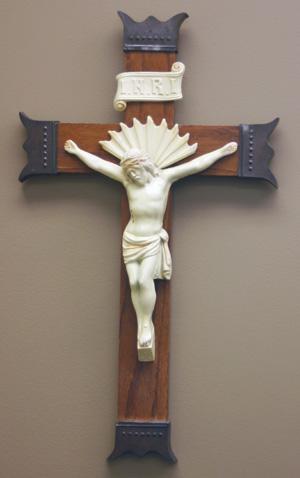
By Barb Arland-Fye
Looking for a crucifix to hang in my office, I found one in the diocesan maintenance office that needed a bit of restoration. With the maintenance crew’s blessing, I took the crucifix — along with their advice about cleaning and restoring it.
The only experience I’ve had with restoration work was as a child observing my mom painstakingly refinishing antique furniture and woodwork in our house. Touching up a crucifix shouldn’t be that complicated, I presumed. Some of the cream-colored paint with a yellow hue had worn off the corpus; the wooden cross was dusty and showing its age and the four ornamental metal ends were weathered.
An employee at Hobby Lobby helped me choose two shades of paint to closely match the original. She examined the crucifix and recommended removing the corpus and cleaning it with water and mild soap before applying touch-up paint. Easier said than done, considering the crucifix is probably around 70 years old and the screws that fastened the corpus to the cross hadn’t been touched in all those years. That evening, having unfastened all but one screw, I set aside the project until my husband Steve returned home and removed the last, stubborn screw.
Cleaning the corpus gave me a sense of being in prayer, meditating in a chapel. My strokes with cloth and toothbrush were as gentle as possible. I felt Jesus’ presence in the kitchen where I was working. Later, I took a paintbrush with the thinnest of hairs and delicately mixed and dabbed paint onto the tip of Jesus’ nose, crown of thorns, hair, knee, toes and his outstretched right arm. I touched up the fan-like halo above his head and the inscription at the top of the cross that reads: I.N.R.I.
Admiring my handiwork, I left the corpus on a towel to dry and began carefully polishing the cross with furniture polish and cleaning the ornamental pieces attached to it. The final step would be reattaching Jesus to the cross. But after the paint had dried, to my dismay, signs of the touch-up were evident. An admitted perfectionist, I fretted about my efforts, mixed some more paint and re-touched what I’d already touched up! Steve assured me that Jesus looked just fine, but I wasn’t quite convinced.
Then God gave me a bit of nudge, as God seems to do more often these days, seeming to say, The handiwork doesn’t have to be perfect, Barb. Jesus died a bloody death on the cross to save a broken, imperfect world of human beings. None of us will become perfect until after we die and are reunited with Jesus in heaven.
The restored crucifix faces me on a wall in my office now, just a couple of feet away from my computer screen. I admire the artwork of the artist who created the crucifix, and wonder how many eyes have gazed upon and prayed before it. This crucifix is not just a work of art; it serves as a reminder of Jesus’ sacrifice and my obligation as a Catholic Christian to express my gratitude in service toward others.









I have a crucifix from many generations ago. It was used when someone is dying in the home. It contains the original candles and holy water bottle. the figure of Jesus is worn and I’d like to restore it along with being refixed to the wooden cross.